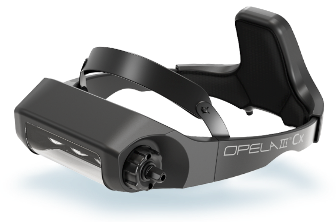Frequently Asked
Questions


General Product Information
-
How is OPELAⅢ different from traditional medical lighting?
Compared to OR lights and headlights, the differences are as follows:
-
Compared to OR lights (Operating Room lights):
The difference lies in the "location of the light source." OR lights are typically installed on ceilings or walls or are freestanding. However, OPELAIII features a light source located on the forehead, near the line of sight or coaxial alignment. This allows it to illuminate deep areas and difficult angles that were previously covered by shadows from surgeon's head or unreachable by OR light.
-
Compared to headlights:
What sets it apart is the "quality of light." OPELAIII offers high illuminance while also reducing shadows, enhancing visibility of surgical field and surrounding inner walls. Additionally, it provides a light that is less strenuous to the eyes — another characteristic that distinguishes it from the glaring light of typical headlights.
-
-
In what situations can OPELAIII be used?
It can be used as an auxiliary light to OR light in operating room settings, and in various environments such as bedside, examination rooms, disaster sites, and emergency vehicles, serving as a portable/wearable OR light.
-
How bright is it?
OPELAIII Cx: 160,000 Lux
OPELAIII: 145,000 Lux
*Center intensity at distance of 400mm with the smallest spot size -
How is it able to reduce shadows?
The light source unit is equipped with three LEDs, which, compared to a single LED, emit light from multiple angles, thus reducing shadows more than traditional setups. (However, it is not completely shadowless when compared to conventional OR lights.)
-
How is high intensity illuminance achieved?
Achieving the high brightness of an OR light requires increasing the power of LEDs and using three of them. The most critical challenge is heat management. In OPELAIII, a unique heat sink mechanism (patented) successfully manages the heat. And in OPELAIII Cx, light conversion efficiency has been improved, successfully reducing the overall heat generation.
-
Is the OPELA III/OPELA III Cx made in Japan?
Yes, it is manufactured in Japan.
-
Is it battery powered? (Can it be plugged into an electric outlet?)
OPELAIII: Only battery operation is available.
OPELAIII Cx: It can be used with battery as well as with external power source (electric outlet). -
How long does it take to charge the battery?
Both OPELAIII and OPELAIII Cx take about 3-4 hours to be fully charged from empty state.
-
Why are nickel-metal hydride batteries used?
While lithium-ion batteries are compact and offer long battery life, there have been numerous reports of smoke emission and abnormal heating, and are designated as hazardous materials unfit for air transport. In contrast, nickel-metal hydride batteries are highly stable and safe for transport even by air. For these reasons, nickel-metal hydride batteries were selected to prioritize safety.
-
What should I do during air transport?
Since the battery unit employs nickel-metal hydride, it is not classified as hazardous and can be transported by airplane with ease. It can be brought onboard as carry-on luggage or as check-in luggage if properly packaged. OPELAIII Cx comes in a special protective case that can also fit in suitcases.

-
What is the recommended method for daily disinfection of OPELAIII and OPELAIII Cx?
Please clean it with disinfectant ethanol using soft cloth. Sterilization is not possible.
-
What are the warranty period and service life?
The service life is 5 years, with manufacturer's limited warranty period of one year. (Service life is subject to manufacturer's recommended regular maintenance.)
-
How long do the LEDs last?
For both OPELAIII and OPELAIII Cx, approximately 50,000 hours.
-
Are there any consumable items?
The battery unit and the inner paddings are consumable items. They are available for purchase as optional accessories.
-
Can it be used with loupes?
It is compatible with most loupes.
*Please verify compatibility before use. -
How often should the battery be replaced?
Depending on frequency of use, it is usually recommended to replace the battery approximately every two years. Consider replacing it when battery life becomes noticeably shorter compared to when it was new.
-
What should I do if I want to purchase it?
Please contact our sales agents or our company directly.
-
Can I use it while charging?
Neither the OPELA III nor the OPELA III Cx can be used while charging, but the OPELA III Cx can be used with an external power source (outlet).
For Healthcare Professionals
This site (OPELAIII Cx Product Website) is designed to provide information on products regulated under the Pharmaceutical and Medical Device Act to healthcare professionals (physicians, nurses, etc.). Access is limited to healthcare professionals only.